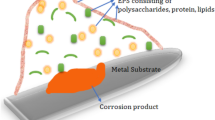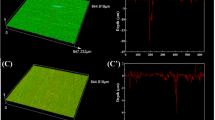Abstract
Microbial colonization of metal surfaces or adhesion of bacteria on metal surfaces is a crucial step in initiating microbiologically influenced corrosion. As the substrate is essential in the development of a biofilm, an understanding of how substrate properties affect adhesion of bacterial cells, including the mechanism of bacterial adhesion, may assist in designing or modifying substrates to inhibit bacterial adhesion and prevent the corrosion of materials. A study was carried out to investigate the effect of nickel on the adhesion and corrosion ability of stainless steels with the same chromium content in nutrient-rich simulated seawater containing Pseudomonas aeruginosa. These stainless steels were 201, 316, 304 and 430 stainless steels. In addition, a carbon steel sample with fully nickel coated was included for comparison. The hydrophobicity of different materials was evaluated by measuring the contact angles made by the water, glycerol and formaldehyde. The number of bacteria adhering to the material surface after short-term immersion was counted by fluorescence microscopy. For corrosion study, the corrosion rates and pitting morphology were studied after 42 days of immersion. The corrosion behavior of the samples was also observed by scanning electron microscope (SEM) coupled with energy-dispersive x-ray spectroscopy (EDX) and inductively coupled plasma mass spectrometry (ICPMS). It was found that the nickel-coated sample had the highest level of bacteria attachment and offered poor corrosion resistance under artificial seawater with Pseudomonas aeruginosa strain. Higher nickel content in stainless steel resulted in a higher level of bacteria attachment. It was found that stainless steel with molybdenum exhibited better corrosion resistance in artificial seawater containing bacteria.








Similar content being viewed by others
References
R. Javaherdashti, A Brief Review of General Patterns of MIC of Carbon Steel and Biodegradation of Concrete, Istanbul Univ. Fac. Sci. J., 2009, 68, p 65–73
J. Stott, What Progress in the Understanding of Microbially Induced Corrosion has been Made in the Last 25 Years? A Personal Viewpoint, Corros. Sci., 1993, 35, p 667–673
E. Heitz and W. Sand, Microbially Influenced Corrosion of Materials, Springer, Berlin, 1996
K. Rabaey and W. Verstraete, Microbial Fuel Cells: Novel Biotechnology for Energy Generation, Trends Biotechnol., 2005, 23, p 291–298
S. Yuan and S. Pehkonen, Microbiologically Influenced Corrosion of 304 Stainless Steel by Aerobic Pseudomonas NCIMB 2021 Bacteria: AFM and XPS Study, Colloids Surf., 2007, 59, p 87–99
J. Morales, The Role of Pseudomonas aeruginosa on the Localized Corrosion of 304 Stainless Steel, Corros. Sci., 1993, 34, p 1531–1540
H. Fleming and G. Geesey, Biofouling and Biocorrosion in Industrial Water Systems, Springer, Berlin, 1991
G.I. Loeb and R.A. Neihof, Marine Conditioning Films, ACS Publications, Washington, DC, 1975
A. Chamberlain, The role of adsorbed layers in bacterial adhesion, in Biofilms—Science and Technology 1992, p. 59–67.
T.R. Neu, Significance of Bacterial Surface-Active Compounds in Interaction of Bacteria with Interface, Microbiol. Rev., 1996, 60, p 151
Y.H. An and R.J. Friedman, Concise Review of Mechanisms of Bacterial Adhesion to Biomaterial Surfaces, J. Biomed. Mater. Res., 1998, 43, p 338–348
F. Lopes, The Influence of Nickel on the Adhesion Ability of Desulfovibrio desulfuricans, Colloids Surf B, 2005, 46, p 127–133
D. Feron, Attachment of Desulfovibrio vulgaris to steels: influence of alloying elements, in Microbial Corrosion: Proceedings of the 3 rd International EFC Workshop 1994.
“Standard practice for the preparation of substitute ocean water”, D1141-98, ASTM International, 2008.
N.R.S.R.M. Jonas, K.K. Ole-Andreas, H.G. Armend, H. Bruusb, and B.T. Stokkea, Simple and Low-Cost Contact Angle Measurements Using a Smartphone with a PDMS-Lens, Royal Society of Chemistry, London, 2016
B. Jańczuk, T. Białopiotrowicz, and A. Zdziennicka, Some Remarks on the Components of the Liquid Surface Free Energy, J. Colloid Interface Sci., 1999, 211, p 96–103
C.J. Van Oss, M. Chaudhury, and R. Good, Monopolar surfaces, Adv. Colloid Interface Sci., 1987, 28, p 35–64
C.J. Van Oss and R. Giese, The Hydrophilicity and Hydrophobicity of Clay Minerals, Clays Clay Miner., 1995, 43, p 474–477
J. Xia et al., Laboratory Investigation of the Microbiologically Influenced Corrosion (MIC) Resistance of a Novel Cu-Bearing 2205 Duplex Stainless Steel in the Presence of an Aerobic Marine Pseudomonas aeruginosa Biofilm, Biofouling, 2015, 31(6), p 481–492
M. Javed, P. Stoddart, and S. Wade, Corrosion of Carbon Steel by Sulphate Reducing Bacteria: Initial Attachment and the Role of Ferrous Ions, Corros. Sci., 2015, 93, p 48–57
“Standard Practice for preparing, cleaning, and evaluating corrosion test specimens”, A Standard G1-03, Annual Book of ASTM Standards 3, 2003, pp. 17–25.
A. Boyd and A. Chakrabarty, Pseudomonas aeruginosa Biofilms: Role of the Alginate Exopolysaccharide, J. Ind. Microbiol., 1995, 15, p 162–168
J. Brandel, Pyochelin, a Siderophore of Pseudomonas aeruginosa: Physicochemical Characterization of the Iron(III), Copper(II) and Zinc(II) Complexes, Dalton Trans., 2012, 49, p 2820–2834
B. Little, P. Wagner, and F. Mansfeld, An Overview of Microbiologically Influenced Corrosion, Electrochim. Acta, 1992, 37, p 2185–2194
S.B. Mulrooney and R.P. Hausinger, Nickel Uptake and Utilization by Microorganisms, FEMS Microbiol. Rev., 2003, 27, p 239–261
P. Sar, P, Nickel Uptake by Pseudomonas aeruginosa: Role of Modifying Factors, Curr. Microbiol., 1998, 37, p 306–311
G. Bao, Corrosion of Stainless Steel 201, 304 and 316L in the Simulated Sewage Pipes Reactor, Huanjing Kexue, 2014, 35, p 3002–3006
K. Hashimoto, The Role of Corrosion-Resistant Alloying Elements in Passivity, Corros. Sci., 2007, 49, p 42–52
F.R.B. Frankel and D.A. Bazylinski, Biologically Induced Mineralization by Bacteria, Rev. Mineral. Geochem., 2003, 54, p 95–114
J. Palmer, S. Flint, and J. Brooks, Bacterial Cell Attachment, the Beginning of a Biofilm, J. Ind. Microbiol. Biotechnol., 2007, 34, p 577–588
A. Deptuła, A. Mikucka, and E. Gospodarek, Influence of Growth Conditions on Cell Surface Hydrophobicity of Multiresistant Pseudomonas aeruginosa Strains, Medycyna Doświadczalna, 2004, 56, p 364
D. Allison et al., Surface Hydrophobicity and Dispersal of Pseudomonas aeruginosa from Biofilms, FEMS Microbiol. Lett., 1990, 71, p 101–104
A. Jayaraman, Axenic Aerobic Biofilms Inhibit Corrosion of SAE 1018 Steel Through Oxygen Depletion, Appl. Microbiol. Biotechnol., 1997, 48, p 11–17
S. Langley and T. Beveridge, Effect of O-Side-Chain-Lipopolysaccharide Chemistry on Metal Binding, Appl. Environ. Microbiol., 1999, 65, p 489–498
B. Atkinson, F. Bux, and H. Kasan, Considerations for Application of Biosorption Technology to Remediate Metal-Contaminated Industrial Effluents, Water S. A., 1998, 24, p 129–135
Acknowledgments
Tien’s Ph.D. candidature is funded by Charles Darwin University RTP scholarship funding.
Author information
Authors and Affiliations
Corresponding author
Additional information
Publisher's Note
Springer Nature remains neutral with regard to jurisdictional claims in published maps and institutional affiliations.
Rights and permissions
About this article
Cite this article
Tran Thi Thuy, T., Kannoorpatti, K., Padovan, A. et al. Effect of Nickel on the Adhesion and Corrosion Ability of Pseudomonas aeruginosa on Stainless Steel. J. of Materi Eng and Perform 28, 5797–5805 (2019). https://doi.org/10.1007/s11665-019-04283-w
Received:
Revised:
Published:
Issue Date:
DOI: https://doi.org/10.1007/s11665-019-04283-w




